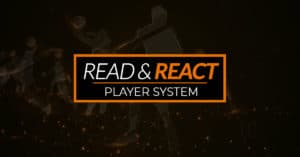Part of effective teaching is putting techniques in terms that are easily transferable and easily remembered. Dynamic Defense helps you do just that.
In order to make proper one-on-one defensive spacing easy to understand, I’ve defined it in terms of a conversation with the help of a personal space bubble.
We all enjoy our personal space and when people operate outside of the societal conventions of that space, things get weird quick. Those conventions can help players quickly recognize appropriate defensive spacing (depending on the situation) while allowing you, the coach, to quickly communicate what you want.
First, use your imagination to picture a translucent bubble surrounding the offensive player. It should be just large enough that if the offensive player extends their arms in front of them, they’ll be touching the edge of their bubble. This is that personal space bubble that we are inherently familiar with.
Now, with the bubble as a guideline, let’s discuss conversational defensive positioning.
Conversation Distance: Most of the time, we want players to play on the surface of the bubble. In other words, they should be stuck to the bubble at all times – close enough to discourage a shot, bother the dribble, and deflect passes. This would be the correct distance to shake hands with another person, or to have a normal conversation. Most well adjusted people instinctively know the appropriate distance socially required to have a one-on-one conversation. That’s conversation distance.
High Talker: If a defender is playing outside the bubble, then he or she is a high talker. That means they would have to raise their voice to have a conversation with the ballhandler. High talkers might be able to protect against the dribble drive, but this position is not going to bother the ballhandler very much. However, there are times where it might be advantageous to take this defensive position.
Close Talker: The opposite of the high talker is the close talker (as made famous in the Seinfeld sketch below). A close talker crowds the bubble to the point of forcing himself inside it. That’s what it means to play inside the bubble. The goal? To make the ballhandler extremely uncomfortable – as uncomfortable as you would be having a conversation inside the bubble.
I’ve found that by putting defensive spacing in terms of a conversation, it’s easy for anyone to judge whether they are too close to the offense, too far away, or just right. And, as a communication tool, a coach can easily tell a player (in any situation) that he or she needs to be a high talker, a close talker, or simply at conversation distance.







